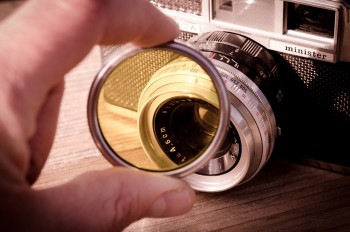This guest post was provided by Eduardo Bridges.
Want to take hazy pictures, photographs of subjects hundred times the original size, or sharp images in low light? Here are several simple and easy photography tricks you can use with your digital camera.
Keep Bright Lights Behind the Subject
If you want your subject to be sharply illuminated, keep the source of the light behind the subject. When the light source—whether it’s the sun or a light bulb—is in front of the subject, the camera will only capture the illumination, not the form of the subject. No matter how high res your DSLR is, if the source of the light is directly in front of the subject, there will be less visibility overall.
Use an IR Filter for Crazy Photographs
 An IR, or infrared filter, is a sensor that blocks all visible light. Your digital camera will essentially be converted to an infrared shooter. IR filters can capture images that are usually not visible under light our eyes can capture. This is why wildlife photographers shoot infrared light into the wild to capture photographs of creatures roaming in the night. In your neighborhood, however, you can use IR filters during the daytime to capture crazy colored images with details that no one would normally see. At night, you might be able to snap highly detailed pictures as well. IR filters are not that expensive and you can even equip a low-end digital camera with one.
An IR, or infrared filter, is a sensor that blocks all visible light. Your digital camera will essentially be converted to an infrared shooter. IR filters can capture images that are usually not visible under light our eyes can capture. This is why wildlife photographers shoot infrared light into the wild to capture photographs of creatures roaming in the night. In your neighborhood, however, you can use IR filters during the daytime to capture crazy colored images with details that no one would normally see. At night, you might be able to snap highly detailed pictures as well. IR filters are not that expensive and you can even equip a low-end digital camera with one.
Use a Drop of Water Instead of a Macro Lens
Can’t afford an expensive macro lens to shoot highly magnified photographs? No problem. Just use a straw to place a drop of water on your lens before shooting your subject. Place the drop carefully. Don’t make it too large so it runs off the lens.
Adjust These Settings to Capture Better Low-Light Pictures
There are three settings on a camera that allow you to capture images in low light settings: ISO, aperture, and shutter speed. ISO is controllable on any camera except smartphone cameras. The ISO numbers shows how sensitive your camera is to light in shots. The higher the ISO, the more sensitive the exposure will be. High sensitivity is great for capturing images when light is really low. But be aware that higher ISO also leads to higher noise.
Many cameras also allow for aperture and shutter speed resetting. Aperture simply refers to how open the camera lens is, and shutter speed means how long the sensor is exposed to light. Obviously, the wider the aperture is, the more light the camera will receive, which means more detail in low light conditions. Reducing the shutter speed also allows in more light. However, if the shutter speed is too low, there is more risk of camera shake. When you adjust these three settings to an ideal level, you can capture sharp images even in low light.
Get the Hazy Effect with a Plastic Bag
Some photographers sometimes manage to shoot stylistically blurred or hazed images. This is not a focusing trick. Use a plastic bag over the lens and you will also be able to capture stunning hazy images.
Use Low Shutter Speeds for Jumpology Pictures
To take a picture where the subject suspended in air seemingly defying gravity, use very low shutter speeds. Low shutter speeds can capture images in motion. Simply put, the shutter speed will be able to capture the subject before it lands back on the ground. No need for fancy software or gadgets. Just adjust your shutter settings.
Try one of the above to transform overnight into a pro photographer.
Eduardo Bridges is a tech blogger and former software engineer. He also likes to take a picture every now and then.